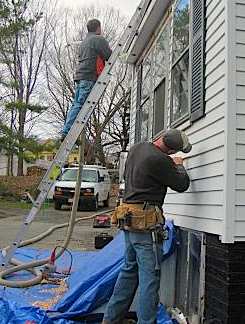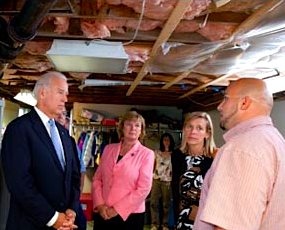 Every year, hundreds of millions of dollars in energy seep through poorly insulated walls, doors and windows in American homes. So in 2009, as the U.S. Congress crafted its economic stimulus bill, lawmakers set aside a record $5 billion to weatherize the nation’s leaky homes.
Every year, hundreds of millions of dollars in energy seep through poorly insulated walls, doors and windows in American homes. So in 2009, as the U.S. Congress crafted its economic stimulus bill, lawmakers set aside a record $5 billion to weatherize the nation’s leaky homes.
The purpose was twofold: to help low-income Americans save money on home heating and cooling bills and to boost job growth in the industry that specializes in residential energy efficiency. The weatherization program funded by the 2009 American Recovery and Reinvestment Act and run by states is now upgrading 25,000 homes a month.
“That’s 200,000 low-income families that will be benefiting from lower energy bills and from increased comfort in the years ahead. It’s absolutely fantastic progress,” said Cathy Zoi, the U.S. Department of Energy’s assistant secretary for energy efficiency and renewable energy.
“What’s more is that we’ve actually created over 13,000 jobs — experienced workers in every state to be able to get that job done.”
By August 2010, one-third of the 600,000 homes scheduled to be weatherized under the law had been fixed — a major milestone for a program that took longer than anticipated to ramp up.
While many taxpayers who foot the bill for the upgrades don’t benefit directly, the expectation is that the economy as a whole will grow when jobs are created and participants in the weatherization program see their disposable income grow — in this case by a collective $70 million.
 Speaking in New Hampshire on August 26, Vice President Biden said that before the Recovery Act boosted home weatherization efforts this year, fewer than 100,000 of the nation’s 110 million homes had been properly insulated. The often-small steps that must be taken to insulate homes have a big impact and an “immediate payoff,” he said. “Investing in weatherization is a no-brainer.”
Speaking in New Hampshire on August 26, Vice President Biden said that before the Recovery Act boosted home weatherization efforts this year, fewer than 100,000 of the nation’s 110 million homes had been properly insulated. The often-small steps that must be taken to insulate homes have a big impact and an “immediate payoff,” he said. “Investing in weatherization is a no-brainer.”
Located in the northeastern United States where winters are long, New Hampshire consumes a great deal of energy for home heating. The state has had more success than most in getting its weatherization program going, which is why Biden traveled there to speak about the program.
Efforts to help U.S. consumers save energy are part of a broader push by the Obama administration to reduce the nation’s dependence on fossil fuels and foreign oil. The policies are having an effect, a new study from the Energy Department’s Lawrence Livermore National Laboratory shows.
In 2009, American energy use dropped 4.6 percent from the previous year. While the economic recession was responsible for most of the decline, rapid investments in wind, solar and geothermal energy, along with an array of energy-efficiency programs, helped reduce consumption of oil, the laboratory reported.
At the current pace, the nation’s weatherization efforts will save 1.5 million barrels of oil annually, the equivalent of taking 107,000 cars off the road, Biden said.
(Source: Bureau of International Information Programs, U.S. Department of State- www.america.gov)



















